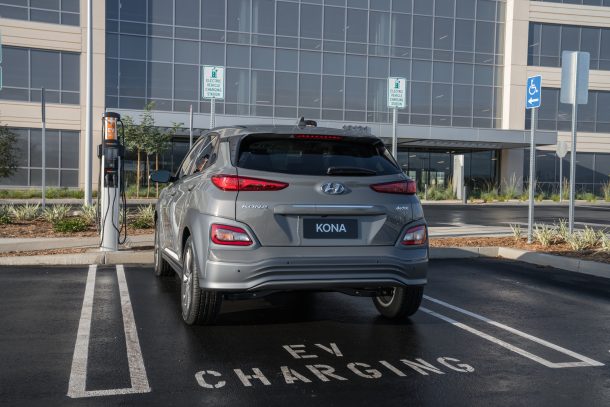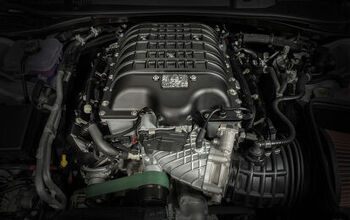Hyundai Being Sued Over Kona Electric Fires, LG Chem on Deck

Hyundai Motor Co. is being sued over a series of battery fires in its electric vehicles in Asia — specifically in relation to the otherwise-enjoyable Kona EV. Though it hardly seems fair to single out Hyundai when General Motors recently issued a recall encompassing 68,677 electric vehicles with batteries manufactured by LG Chem. Interestingly, Hyundai’s 74,000-strong Kona recall (which includes 11,082 units sold to the United States and Canada) uses the same supplier.
EV fires have become a hot topic within the industry, specifically because it runs the risk of slowing adoption rates and makes the affected automaker look wildly inept. Lawsuits don’t help the matter but Hyundai’s more immediate concerns involve proving that LG is the one that screwed up. While it hasn’t pointed any fingers directly at the supplier, it has dropped subtle hints while LG Chem insists its products are not defective. The duo is reportedly collaborating on an internal investigation into the troubled vehicles — 16 of which have burst into flames in North America, Europe, and Asia.
From Reuters:
South Korea’s safety agency is investigating the cause of the Kona fire, and depending on the results, Hyundai and LG Chem could face costs up to $540 million if they have to replace all the affected batteries, analysts reckon.
In a statement to Reuters, Hyundai said the cause of fire is unclear but it suspects that internal damage to batteries may be to blame, adding that it is investigating the case with its supplier and the transport ministry.
Hyundai said it is not considering setting aside money for recalls as it expects its software fix will be able to prevent fires by detecting problems.
“We are constantly monitoring the situation after an update of the [battery management system] and we will continue to try to minimize consumer inconveniences going forward,” Hyundai said.
A LG Chem spokesman said, “We will cooperate with Hyundai Motor and General Motors and sincerely proceed with an investigation to identify the exact cause” of the fire.
This isn’t the first time automakers and battery suppliers have been at odds with each other. Ford and BMW have also recalled vehicles equipped with batteries from Samsung SDI, suggesting the contributing defects were inherent to their design. Unfortunately, the investigations are ongoing and have yet to prove if the batteries were manufactured poorly or that modifications made by automakers are what ultimately made them unstable.
Reuters noted that LG Chem CEO Hak Cheol Shin stated in an interview from last month that its battery systems could have been negatively affected by components made by Hyundai suppliers. But he doesn’t want to accuse anybody until there’s been an investigation into the fires. “As a supplier of a key component of the battery system, we clearly feel responsibility. But until a clear cause would be determined, we can’t come up with measures to address the problems,” he explained.
While the number of EV fires wasn’t terribly out of whack with their gasoline equivalents when this all started, the Kona Electric recall actually has an unpleasantly high number of confirmed fires. The same was true for Chevy’s Bolt. Unfortunately, the default solution has been for automakers to issue software updates that prohibit vehicles from achieving their maximum charge (lowering range). But that doesn’t seem sufficient to give consumers peace of mind, especially when EV fires are particularity explosive, so many of them happened while vehicles were charging overnight, and the issue extends beyond Hyundai and GM.
[Image: Hyundai]

A staunch consumer advocate tracking industry trends and regulation. Before joining TTAC, Matt spent a decade working for marketing and research firms based in NYC. Clients included several of the world’s largest automakers, global tire brands, and aftermarket part suppliers. Dissatisfied with the corporate world and resentful of having to wear suits everyday, he pivoted to writing about cars. Since then, that man has become an ardent supporter of the right-to-repair movement, been interviewed on the auto industry by national radio broadcasts, driven more rental cars than anyone ever should, participated in amateur rallying events, and received the requisite minimum training as sanctioned by the SCCA. Handy with a wrench, Matt grew up surrounded by Detroit auto workers and managed to get a pizza delivery job before he was legally eligible. He later found himself driving box trucks through Manhattan, guaranteeing future sympathy for actual truckers. He continues to conduct research pertaining to the automotive sector as an independent contractor and has since moved back to his native Michigan, closer to where the cars are born. A contrarian, Matt claims to prefer understeer — stating that front and all-wheel drive vehicles cater best to his driving style.
More by Matt Posky
Latest Car Reviews
Read moreLatest Product Reviews
Read moreRecent Comments
- Joe65688619 Under Ghosn they went through the same short-term bottom-line thinking that GM did in the 80s/90s, and they have not recovered say, to their heyday in the 50s and 60s in terms of market share and innovation. Poor design decisions (a CVT in their front-wheel drive "4-Door Sports Car", model overlap in a poorly performing segment (they never needed the Altima AND the Maxima...what they needed was one vehicle with different drivetrain, including hybrid, to compete with the Accord/Camry, and decontenting their vehicles: My 2012 QX56 (I know, not a Nissan, but the same holds for the Armada) had power rear windows in the cargo area that could vent, a glass hatch on the back door that could be opened separate from the whole liftgate (in such a tall vehicle, kinda essential if you have it in a garage and want to load the trunk without having to open the garage door to make room for the lift gate), a nice driver's side folding armrest, and a few other quality-of-life details absent from my 2018 QX80. In a competitive market this attention to detai is can be the differentiator that sell cars. Now they are caught in the middle of the market, competing more with Hyundai and Kia and selling discounted vehicles near the same price points, but losing money on them. They invested also invested a lot in niche platforms. The Leaf was one of the first full EVs, but never really evolved. They misjudged the market - luxury EVs are selling, small budget models not so much. Variable compression engines offering little in terms of real-world power or tech, let a lot of complexity that is leading to higher failure rates. Aside from the Z and GT-R (low volume models), not much forced induction (whether your a fan or not, look at what Honda did with the CR-V and Acura RDX - same chassis, slap a turbo on it, make it nicer inside, and now you can sell it as a semi-premium brand with higher markup). That said, I do believe they retain the technical and engineering capability to do far better. About time management realized they need to make smarter investments and understand their markets better.
- Kwik_Shift_Pro4X Off-road fluff on vehicles that should not be off road needs to die.
- Kwik_Shift_Pro4X Saw this posted on social media; “Just bought a 2023 Tundra with the 14" screen. Let my son borrow it for the afternoon, he connected his phone to listen to his iTunes.The next day my insurance company raised my rates and added my son to my policy. The email said that a private company showed that my son drove the vehicle. He already had his own vehicle that he was insuring.My insurance company demanded he give all his insurance info and some private info for proof. He declined for privacy reasons and my insurance cancelled my policy.These new vehicles with their tech are on condition that we give up our privacy to enter their world. It's not worth it people.”
- TheEndlessEnigma Poor planning here, dropping a Vinfast dealer in Pensacola FL is just not going to work. I love Pensacola and that part of the Gulf Coast, but that area is by no means an EV adoption demographic.
- Keith Most of the stanced VAGS with roof racks are nuisance drivers in my area. Very likely this one's been driven hard. And that silly roof rack is extra $'s, likely at full retail lol. Reminds me of the guys back in the late 20th century would put in their ads that the installed aftermarket stereo would be a negotiated extra. Were they going to go find and reinstall that old Delco if you didn't want the Kraco/Jenson set up they hacked in?


































Comments
Join the conversation
No word yet on problems with the Ioniq EV; hopefully its relationship to the Kona EV doesn't include any troublesome DNA. Pack design is the usual culprit; not the cells themselves. Good pack design allows for a cell to short without fatal consequence, proper spacing, ventilation, overcharge protection, shipping protection, thermal protection, overpressure protection, and so on. Finding the root cause will be tough, so it may require a top-to-bottom design, tolerance, and mfg review. They're not talking about who held responsibility for which aspects of the design. Ownership of the design is likely defined legally, but I'll bet it falls to Hyundai as the final check on what goes out the door. Maybe LG Chem messed something up, but Hyundai can't simply trust them without verification of their work. Same was true of the crankshaft scenario - Hyundai's 3rd party mfr made a terrible oversight, but Hyundai never caught it.
Unless GM made a similar packaging mistake with the Bolt, seems likely that LG Chem will face the brunt of the cost.